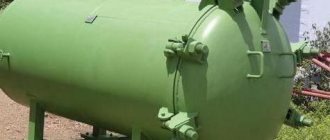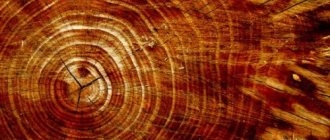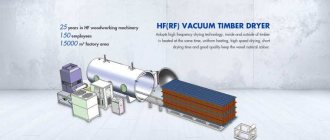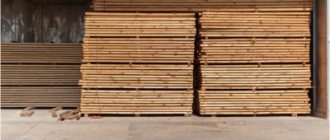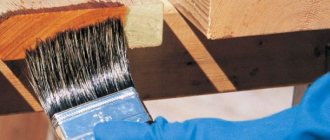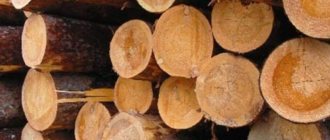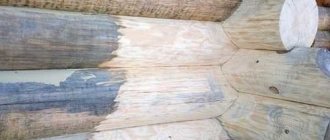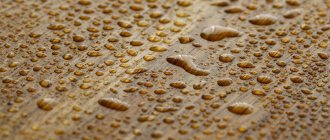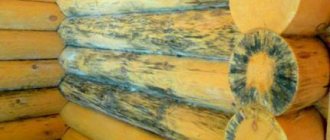How does drying wood by boiling in salt work?
Wood contains liquid. Namely, it is contained in the capillaries of the tree trunk. The liquid that the tree absorbs from the soil and the external environment is necessary for the tree to support its life. In addition to water, it also contains nutrients.
Wet wood is not used in production. Well, or at least you can’t use it. Since it is difficult to process, it may not stick together and during use it can change its shape, deform and warp, which will lead to the appearance of cracks, cracks and many other unpleasant “surprises”.
For use in various industries, standard wood should have no more than 12% moisture content. This indicator is a kind of standard. Wood can also be dried naturally. You just need to place the lumber in a well-ventilated, dry area. But one of the disadvantages of natural drying is that it takes a lot of time. By boiling wood in salt, this process can be significantly accelerated.
Bound moisture and its features
Wood is a porous material, which is dotted with pores and channels into which water enters, and thereby nourishes the plant with the minerals necessary for growth. This moisture is called “free.” It is removed from the wood structure even during atmospheric drying, but in addition to free spaces, there is also moisture bound in the wood. We are talking about that part of the water that is found in the tissues and cells of wood, and takes part in the formation of lumber as a durable and reliable type of building material.
It is quite difficult to evaporate such moisture, and in most situations it is completely unrealistic, because it is located in microscopic pores that will remain inaccessible even with strong overheating by the air flow. If, during the evaporation of free moisture, the wood material does not change its physical and chemical qualities, then...
When bound moisture evaporates, the wood will undergo changes:
- It changes its structure greatly.
- Loses its former strength.
- Changes in linear dimensions.
- The shape changes.
Bound moisture can occupy a large proportion of the total, and if the total moisture level in the wood is more than 30%, then this will indicate the presence of free moisture in it, and therefore such lumber can be dried again. The wood is dried in order to carry out its subsequent processing and impart the required qualities. It is necessary to boil the wood to prevent cracking and protect against putrefactive microbes getting inside. There are two most popular methods for boiling - drying in salt water, and boiling in oil and drying oil. In addition, drying in urea or carbamide (that is, in a hydrophobic solution) is often used.
Drying wood by boiling in salt
- You can boil wood without salt, in plain fresh water, but boiling it in a saline solution has a greater effect.
- In addition to speeding up the drying process of wood, boiling in salt also improves the quality of the wood.
- In the process of boiling wood in a saline solution, the process of removing juice from its cells is accelerated. This reduces the total time spent drying wood.
- In addition, boiling in salt makes the wood softer and speeds up the drying time, which helps prevent the product from changing shape and cracking during further drying. The appearance of wood improves after boiling in salt.
Another important and significant advantage of boiling wood in salt is the additional protection of the wood from rotting and damage by bacteria and fungi.
Condensation
Condensation drying of wood is the most popular method that optimally combines cost and quality. The wood dries at low temperatures using a kiln and refrigeration equipment. Moisture is removed using condensation, which makes drying uniform and gentle. Therefore, the products are of high quality and durable without cracks or manufacturing defects.
Drying with condensate consumes little energy, which makes lumber accessible and inexpensive. Logs and beams are smooth and aesthetically attractive without cracks or other defects. However, the use of such drying is not rational for small lumber and products. But it is suitable for large-sized timber with a large cross-section that requires careful and gentle drying.
Therefore, the MariSrub company uses chamber drying for timber and logs. We independently procure raw materials and produce lumber. To protect living wood from moisture, ultraviolet radiation and insects, we process products at the stage of manufacturing, frame assembly and finishing. MariSrub masters control every stage of production, including drying in condensation chambers.
https://youtube.com/watch?v=0kZBKKbzzxA
Boiling wood in salt yourself, at home
The only caveat of boiling wood in salt at home is the limited size of the product that can be processed. The size depends on the size of the container you have on hand.
Those who often work with wood make baths with built-in heating elements or use a fire.
For digestion we will need a 25% salt solution. We prepare the saline solution in a container where we place the wood. You need to cook the wood over medium heat for three hours. The boiling time may vary depending on the amount of wood in the container.
For small wooden elements, you can use a large saucepan, preparing a solution at the rate of 5 tablespoons of salt per liter of water.
After boiling, the hot wood is removed from the solution and allowed to dry.
Subscribe to our Yandex.Zen channel
Overview of options
Drying wood in salt water
Wood is boiled in salt using a 25% saline solution. The wood should be placed in a container filled with saline solution, and then everything should be cooked over medium heat for 2-3 hours. The time may vary depending on how much wood you are trying to boil. Wood is dried in salt water, the material is heated, which makes it possible to remove bound moisture with minimal losses to the geometry of the lumber.
Boiling wood in drying oil and oil
Boiling wood in oil makes it possible not only to prevent cracking in the wood, but also to enhance the expressiveness of the wood material. When cooking, the oil begins to push water and air out of the wood because it gets into the intercellular spaces. Next, the wood should be dried, and as a result it can be easily and simply sanded and polished. The boiling technology is quite labor-intensive and requires direct human work, as well as further drying. It is used for small-sized samples, even for saw cuts. On an industrial scale, drying with oil or even salt will be completely impractical, and this is mainly used for domestic conditions. In the case of small productions, drying chambers are used, sometimes even vacuum ones.
Drying and thermal modification of wood by cooking in oil
If everything is clear with drying wood with salt, then with oil things are somewhat different. We are talking about an oil bath with a temperature of +150...+250 degrees. So, any oil, any kind, will act as a heating agent - it will evenly transfer heat into the wood and remove water vapor, as well as air, which is actively released during boiling (this is drying), and also does not allow oxygen to reach the wood, which will prevent charring.
The main feature of this process is that it is impossible to cool the wood in an oil bath, because inside the wood there will be water vapor heated to +250 degrees, which, when compressed to room temperature, will create a vacuum that sucks oil into the wood, and this is unacceptable . The tree should be removed from the hot oil, and you will hear it suck in air with a whistle (but there is a peculiarity here - an example is described of cooking a block measuring 10*10 cm, and from abrupt removal it cracked inside).
As a result, after several hours of cooking you get thermally modified wood, dried to 3-4%, which is not subject to warping in the future. The oiled layer of the material will be approximately 0.5 cm, and it is usually cut off, and then they work with the wood as usual - glued, impregnated with stain, painted and varnished.
Here is the result of the procedure: “Wood boiled in oil begins to be saturated with oil, but no more than 0.5 cm (and usually 0.2 cm) along the face, no more than 10 cm from the end (we are talking about deep impregnation until the color is dark). ). The material in such an area will release oil when pressed hard or even when cut - it has a dark brown color. Such places should be removed using a surface planer and the ends cut off. The inside of the wood has a light yellowish tint, and the humidity ranges from 3 to 5%. Epoxy resin holds such wood, and everything is sanded perfectly.
When covering with stain and alkyd varnish PF-283, no problems with adhesion were noticed. Birch, which is more than 6 cm thick, can easily be torn inside by oblique tears in the depths of the block (everything is intact on the outside, and such problems usually appear after sawing), but all because the wood was taken out of the oil too quickly.”
And here is another result: “The board was placed only in heated oil, the temperature of which was not less than +110 degrees. The mass temperature is +120 degrees. The oil used was the simplest one, sunflower, from the store. You can try adding dryers, but there is no point in them, because a 5 cm thick birch board will dry for 7.5 hours. By the way, it is not difficult to control the process. When the board is immersed, foam begins to release strongly, and by the end of drying the board will practically not release air bubbles. With hard work, the moisture content of the board is from 2 to 4%.”
Thermally modified wood - what is it?
When heated to +250 degrees without air (it does not matter in what way - under an oil layer, in an atmosphere of inert gas or even with water vapor), a change in the aggregative state of a substance in wood such as lignin occurs, and thermal destruction of polysaccharides also occurs, which
are excellent nutrients for bacteria:
In an inert atmosphere without oxygen, carbon dioxide and monoxide begin to be released from wood.- The main components of wood are cellulose, extractives, hemicelluloses, lignin, which is formed at a temperature not higher than +20...+500 degrees.
- Since the temperature of thermal modification is above +1000 degrees, such components from the lignocarbohydrate matrix begin to transform into another state, more thermally stable.
- As a result of prolonged exposure to the hydrothermal type, hemicellulose begins to decompose into smaller reactive molecules, but the strength of the wood does not decrease. Quite the contrary, breaking the hemicellulose chain will improve the wood’s resistance to compression and reduce internal stress. In addition, it is believed that lingin becomes a different type of reactive molecule.
All this contributes to changes in the woody cellular structure. But cellulose remains unchanged. During heat treatment, the carbohydrate part decomposes and the moisture content inside the wood decreases, and this increases the resistance of the wood to the process of decay. Under standard conditions, it is often with carbohydrates that provides a nutrient medium for microscopic organisms.
Impregnation of wood with oil during cooking
Drying wood by boiling it in salt is not as effective as the method with oil. By the way, this is the same process as described above, but at the end the wood is cooled in oil, which is why it penetrates into the very depths of the wood. As a result, the material will not adhere well and will require careful degreasing of the gluing area, and not every adhesive composition is suitable for this. But such wood is not afraid of water at all, and will not shrink or warp. This is exactly what is required for the wood decking and latticework on the deck.
Preparation
In order for the drying process, regardless of the chosen method, to be successful, the wood needs to be prepared by following these steps:
Remove the bark from the beams and boards. This is necessary to prevent microorganisms from settling on and in the wood. Insects. The round timber must be sawn into boards of the required thickness, beams
If technical drying occurs, then the dimensions of the drying chamber in which the process will take place must be taken into account. When laying in the chamber, take into account the width allowance so that deformation, which often occurs during drying, does not create interference. The shape of the wood changes in any case, because its volume decreases as a result of the removal of excess moisture.
Drying system in production
Setting up and conducting the experiment
The experiment was carried out on a semi-industrial chamber installed at OJSC UralNIIPDrev and described in Chapter 3.
When choosing constant and variable factors, the results of studies conducted earlier on this camera were taken into account.
The purpose of the experiment is to determine the rational values of control factors when implementing biofeedback drying modes.
As the main experiment, a type B3 design was implemented.
Constant factors during the experiments, as well as their values, are given in Table 4.14.
Variable factors during the experiment, their values in explicit and coded form, as well as ranges of variation are given in Table 4.16.
From the diagram shown in Figure 4.13, it follows that as a result of the experiment, the dependences of each (first 3) output parameter on all input parameters will be obtained in the form of a second-order polynomial. Each of these polynomials represents a mathematical model of the drying process for a specific output parameter. The presence of such models makes it possible to optimize the process for each output parameter separately, and then determine the rational values of the drying mode parameters as a result of solving the compromise problem using the conditional center of mass method.
– As for the fourth output parameter - internal stresses during drying, it is determined qualitatively according to the standard method recommended by RTM.
The methodological grid for conducting the experiment is given in Table 4.17.
A little about the properties of wood
The humidity of a growing tree depends on the time of year: in early spring the humidity is highest, but in winter, on the contrary, it is minimal. If you harvest wood when it has a low moisture content, it will be more resistant and will crack less when dried. The more the material dries, the larger and deeper the cracks in it. “Soft” wood dries out less, but faster than hard wood.
There are three groups of rocks (according to the degree of shrinkage):
- Severely drying: birch, apple, larch, maple;
- Medium: aspen, elm, oak, ash, linden;
- Small degree (often coniferous): cedar, spruce, pine, poplar, willow.
Proper drying of boards is a complex process.
Wood has the properties of absorbing moisture like a sponge. When exposed to humid air, wooden boards absorb tiny drops from the environment, swelling and becoming larger. Dry air makes wood drier and smaller
It is important that the tree obtains an equilibrium moisture content with the surrounding air
It would be ideal if the boards were dried evenly to the humidity level at which they are planned to be used
This rule is important for drying wood in any conditions, be it a special drying chamber, a garage or an open area on the street.
Craftsmen note that due to the reduction in the mass of wood after drying, it is much easier to work with it than with wet wood.
This process has its own difficulties:
- each type of wood requires a separate approach; drying birch and fir, for example, is different;
- if something goes wrong: the process of rotting has begun or the wood has cracked, then the boards will have to be thrown away or energy spent on masking the damaged areas;
- It is necessary to dry it in a thoroughly ventilated area; sometimes it is necessary to build fans and homemade electric dryers.
Wood moisture measurement
The only possibility for sure
To measure the moisture content of wood is to dry test pieces of material in an oven until their weight stops decreasing. Various methods for measuring weight can be found in reference books. In principle, a satisfactory result can be achieved at home by heating the material in the oven and using fairly accurate scales (±1 g).
It is more convenient and faster to estimate the moisture content of wood using special moisture meters - moisture meters. Currently, two devices with different operating principles are common:
- needle meters, in which two needle electrodes located at a certain distance from each other are stuck into the wood and the electrical voltage between them is measured;
- meters, where a sensor plate generating an electromagnetic field is installed close to the surface of the wood and all changes affecting the magnetic field are recorded.
What is wood moisture content
During construction work and for the manufacture of wooden products, wood with a moisture content of no more than 23% is usually used. In practice, several types of wood are distinguished depending on its moisture content:
- wet – humidity more than 23%;
- atmospheric-dry – humidity 18 – 23%;
- air-dry (after artificial drying) – humidity 12 – 18%;
- room-dry – humidity 8 – 12%.
The lower the wood moisture content, the less susceptible it is to rotting. In addition, after drying, almost all properties of wood that are important for use are improved:
- its strength increases;
- deformability decreases;
- the quality of sawing, grinding, gluing, painting improves;
- indicators such as electrical conductivity and heat capacity decrease, the calorific value increases;
- The density of wood is directly related to its moisture content; the drier the wood, the lighter it is.
There is also the concept of equilibrium moisture content of wood. This means that at certain values of air humidity and temperature, the moisture content of wood remains unchanged and tends to a certain value.
If these parameters change, the wood will either release moisture into the surrounding atmosphere or absorb it until the humidity reaches a new certain value.
Thus, during the drying process of wood, its moisture content is deliberately reduced to equilibrium values, depending on where and how the lumber will be used.
Main types of drying chambers
Drying complexes for wood can be classified according to many criteria.
According to the method of moisture removal:
- Convection. Heat transfer in them occurs by convection. There are tunnel and chamber ones. Tunnel. An elongated structure, at one end of which lumber intended for drying is loaded, and at the other end it is removed dry.
- Chamber. When drying, a certain temperature is set in the chamber, which is maintained at the required level using special equipment. This type is the most commonly used.
Condensation. Water vapor evaporated from wood is not removed by the air flow, but enters special devices (condensers), where it cools and turns into liquid water. Such drying devices are ideal for heavy breeds.
By air circulation method:
- With natural circulation. In them, the wood is dried unevenly, and productivity is low.
- With forced circulation.
What defects can form?
In the process of drying lumber, wood defects may appear in the workpieces, which are usually divided into hidden and obvious, that is, visible to the naked eye. If the natural tension of wood fibers exceeds permissible limits, then visible defects are formed, which usually include any cracks, fungal or mold damage, loss of knots, darkening of the wood color, as well as warping of the workpieces.
The appearance of hidden defects occurs after the formation of stresses in wood fibers, which is facilitated by the uneven distribution of moisture relative to the cross-section of the workpiece. In addition, uneven drying of the material is considered a hidden defect; this is most often observed when stacking workpieces during drying. The appearance of cracks, wrinkling, and warping in wood is usually caused by uneven drying. Defects of this kind can be seen on the end sections of workpieces; in addition, they can also appear in the form of internal or surface cracks located on the plane of the board.
The appearance of cracking in the end parts of workpieces is the most common type of defect, which manifests itself earlier than other types of drying defects. This is explained by the fact that the evaporation of moisture at the end parts of the board or beam occurs due to the high moisture conductivity of wood fibers located in the longitudinal direction. Loss of moisture causes shrinkage and tension in the fibers. The higher the degree of such stress, the greater the likelihood of the formation of cracks, which most often appear in the radial direction. A correctly selected drying mode, which will not cause the tensile strength of wood fibers to be exceeded, helps to avoid such a defect.
The formation of cracking in wood material occurs in stages. At the beginning of this process, shallow and small cracks appear, the direction of which is oriented deep into the thickness of the material by 4-5 mm. If at this stage the drying process is continued with the same parameters, then minor cracks will begin to expand, they can go even deeper into the wood structure and penetrate the entire cross-section of the workpiece.
As for such a defect as warping, on lumber it can be helical, as well as longitudinal and transverse. All types of warping can be present even on one workpiece, but only one of them will be clearly visible. Most often, lumber with a wide surface area of 20 cm or more is susceptible to transverse warping. This defect is especially often visible when sawing mixed or tangential types.
When sawing radially, the workpieces are subject to warping quite rarely. The quality of the wood also influences the twisting of lumber or its longitudinal warping. For example, such a defect most often occurs if the original workpiece has a heel or cross-layered wood fibers, but it is advisable to discard such workpieces even before the drying process begins. Warping is a consequence of a violation of the technology of the wood drying process. During storage, the formation of this defect can be caused by an insufficient number of spacers between the boards, as well as different heights of such spacers.
If you unload uncooled materials from the drying chamber immediately after the end of the drying cycle, there is a risk that the wooden blanks will be subject to warping after cooling. To avoid the appearance of such a defect, you will need to not only follow the technology of the material drying process, but also the rules for its storage. For this purpose, in a stack of lumber, the top 2-3 rows of blanks are secured in special pneumatic clamps, and sometimes a load pressing on them is evenly placed on top of the dried boards.
Need for drying
Wood blanks in the form of logs have a high degree of moisture, so they will need to go through a cycle called wood drying. The moisture contained in the workpieces can gradually decrease naturally, but this will take a long time and will lead to a chaotic phenomenon of compression and expansion within the wood fibers. For this reason, drying of workpieces is carried out under strict control and under certain conditions.
Damp and undried wood structure has a tendency to rot, crack and bend. To avoid such unfavorable phenomena, various methods are used to bring wood to condition, with specified humidity level parameters. Drying conditions and cycle duration directly depend on the method of removing excess moisture.
Infrared
Infrared wood drying is a modern method using equipment that transfers heat using infrared radiation. This is one of the fastest options for drying lumber, which takes 3-7 days depending on the type of wood. The sawdust drying time will be half an hour. The process occurs at a temperature of 50-60 degrees, which preserves the structure of the wood and protects it from cracking.
Infrared cameras remove moisture evenly. They are economical and comfortable to use. However, when using the chamber indoors, due to the lack of air flow, mold appears on some areas of the lumber. Therefore, it is better to dry only in the open air under a canopy.
How to dry boards quickly
There are times when you need to quickly dry small boards at home, which is especially important in winter. There is one simple, time-tested method for this.
The essence of the method is as follows. A board from a recently cut tree is wrapped in paper (5...15 layers), then the material is wrapped in plastic film and several holes are made to allow moisture to escape.
The pre-prepared board is placed on a heated radiator or other place located in close proximity to the heating device. As the wood dries, some of the moisture will be absorbed by the paper, so the wrapping material needs to be changed 3-4 times a day. While drying, the board needs to be turned over several times a day.
The drying time of lumber depends on its thickness. So, three days are enough to dry a 3-centimeter board.
Products of greater thickness take longer to dry, but much faster than with natural drying.
The method under consideration has one significant drawback - deformation of the wood surface. This disadvantage can be easily corrected by processing the board with a plane.
Wood drying technology
Wood drying technology includes the use of modern equipment using special knowledge and personal experience. Since raw materials in their raw form do not have the strength that is expected of them, they must be handled carefully. If not dried properly, the wood may burst or separate along the fibers. All this will lead to unusability of the lumber.
The drying process consists of alternately using high and low temperatures. The first stage involves intensive heating of the material. When the liquid evaporation temperature is reached, the material loses moisture from the upper fibers. At the same time, its mass also decreases by approximately 40-50%. Various heat sources can be used for heating. Often, their operation is regulated by several sensors, so that the entire process runs smoothly and safely. Only in this case is it possible to quickly dry the wood.
High-temperature drying of wood promotes rapid evaporation of moisture from the upper layers of wood. There are other types of drying, but they all involve some investment in one way or another. However, quite a lot of liquid remains in the middle of the product, which also needs to be evaporated. If you continue to heat the wood, excess pressure forms inside. Since the outer layers are already dry, steam from the inner fibers tends to escape. The outer fibers are less elastic, so they will not withstand the internal pressure and will burst. To avoid this, use the steaming method.
The raw material is exposed to superheated steam, due to which the upper layers of the wood soften and become more elastic. This allows the accumulated steam inside to escape without tearing the wood. The steam exposure is also controlled by sensors to achieve complete drying.
After the material has dried completely, it must be moistened to a certain ratio. This procedure is necessary for the product to gain some elasticity and firmness. Completely dry material is extremely brittle and should not be used during construction. Humidification allows you to adjust the moisture content of the internal and external fibers of the lumber. To achieve maximum effect, these operations are repeated several times, starting with heating. Thanks to this, the finished product has both strength and flexibility.
It is important to correctly establish the cyclicity of processes and observe all wood drying modes
Drying technology
There are several types of drying technologies used in industry. All of them can differ in the types of equipment used, as well as in the various ways in which the heat itself is transferred to the material that is being dried.
Distribution of cold and warm air flows during drying
Basically, technological processes for drying different types of wood are divided into the following types:
- conductive drying method;
- Radiation technologies are also being used;
- The main technology for drying the material is the use of electricity
- technological process of convective drying of wood.
Convective drying of wood
Expert advice
When drying wood, it must be remembered that the duration of the process depends on what type of wood will be used. For example, oak boards can take a long time to dry; this process under natural conditions takes up to 7 years. Some rocks crack when dried, and this only worsens the quality of the surface. If you are not sure that everything will be done correctly, then it is better to purchase ready-made wood that has the required level of moisture.
Experts advise using 2 methods of drying wood:
- The logs are sanded along the middle part, but the bark is left at the ends; the width of such a strip is approximately 100 mm.
- The bark is not removed, but cuts are made across the trunk to provide air access. The bark is not cut along; in this case it acts as an excellent tightening clamp.
During drying, you need to be guided by what types of wood and how they react to the drying process:
- Alder, linden, birch, aspen and poplar do not crack during drying. The surface of the workpiece remains smooth and of high quality.
- Wood species such as larch, spruce, cedar, pine, and fir crack to a small extent. They are often used for construction, as they have all the necessary characteristics. This material is durable, can withstand even heavy loads, and has a pleasant aroma and color.
- When drying, beech, hornbeam, maple, and ash crack greatly. When choosing this type of wood, it is best to take already dried and ready-made boards that have undergone factory processing, since it is difficult to prepare them with your own hands and a large percentage of waste is obtained.
Various methods are used for drying wood. During the drying process, the boards can not only lose some of their volume (there is a lot of moisture in wood), but also become deformed and become covered with cracks. And this is already unacceptable for building structures. That is why experts advise devoting the proper amount of time to preparing the material.
